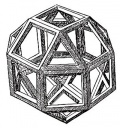Pinhole camera
From The Art and Popular Culture Encyclopedia
|
Related e |
|
Featured: |
A pinhole camera is a simple camera without a lens and with a single small aperture — effectively a light-proof box with a small hole in one side. Light from a scene passes through this single point and projects an inverted image on the opposite side of the box. The human eye in bright light acts similarly, as do cameras using small apertures.
Up to a certain point, the smaller the hole, the sharper the image, but the dimmer the projected image. Optimally, the size of the aperture should be 1/100 or less of the distance between it and the projected image.
A pinhole camera's shutter is usually manually operated because of the lengthy exposure times, and consists of a flap of some light-proof material to cover and uncover the pinhole. Typical exposures range from 5 seconds to hours and sometimes days.
A common use of the pinhole camera is to capture the movement of the sun over a long period of time. This type of photography is called Solargraphy.
The image may be projected onto a translucent screen for real-time viewing (popular for observing solar eclipses; see also camera obscura), or can expose film or a charge coupled device (CCD). Pinhole cameras with CCDs are often used for surveillance because they are difficult to detect.
See also
- Pinhole glasses
- Spatial filter
- Zone plate
- Dirkon
- Fox Talbot
- Wolf Howard
- Billy Childish
- Jesse Richards
- Pinhole camera model
- Nautilus (its lens-less eye functions as a pinhole camera)
- Pinhole occluder, a similar device used by ophthalmologists

